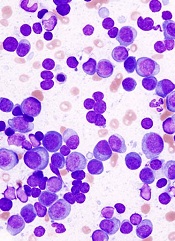
NEW YORK—It’s important to use the best possible regimen as soon as possible when treating patients with multiple myeloma (MM), according to a speaker at Lymphoma & Myeloma 2016.
Antonio Palumbo, MD, of the University of Torino in Italy, explained that the urgency, from a biological point of view, is because myeloma accumulates genetic mutations that change the disease in a “dramatic way.”
“At diagnosis, you might have 5000 mutations, and, at first relapse, there are 12,000 mutations,” he said. “They are completely different tumors. So the first thing that we have to recognize is that, with time, myeloma is not the same. It’s becoming different tumors.”
Dr Palumbo noted that early intervention is important because genetic and epigenetic abnormalities increase as the disease progresses and becomes more resistant.
For example, if 100 patients receive first-line treatment, 40 of them will not reach the second line. Only 60 patients will receive second-line therapy, and only 35 patients will receive third-line treatment. By the fifth line, only 10 patients, or 10%, will receive it.
“If you have very good genomic stability, you can become sensitive to different treatments,” Dr Palumbo said. “But if you become a different disease, you will not be able to receive the next therapy. That’s why it’s so important . . . to use the best possible regimen as soon as possible.”
Best regimens
The triplet bortezomib-lenalidomide-dexamethasone is the “best possible regimen today,” Dr Palumbo said, “followed by continuous therapy.”
The 2-drug combination of lenalidomide and dexamethasone is probably more suitable for the elderly and the frail.
Alternative regimens include carfilzomib-cyclophosphamide-dexamethasone and ixazomib-lenalidomide-dexamethasone.
Continuous therapy
Continuous therapy has been “one of the major achievements” in the treatment of MM, Dr Palumbo said. Without continuous therapy, patients in complete response remain so for about 1 year when treated with conventional chemotherapy.
Investigators found that maintenance therapy significantly prolongs progression-free survival and overall survival (P=0.02). They recommend intensification with maintenance to optimize treatment efficacy and prolong survival.
Immunomodulatory drugs such as lenalidomide are the backbone of continuous therapy today.
However, ixazomib represents another option. Ixazomib maintenance has been shown to produce durable responses for a median of more than 2 years in previously untreated patients not undergoing autologous stem cell transplant.
Salvage therapy
Seven combinations are now available for salvage therapy, including those with proteasome inhibitors, monoclonal antibodies, pomalidomide, and histone deacetylase inhibitors.
Included in some of these combinations are the newer agents ixazomib, elotuzumab, and daratumumab, “which many might consider the new rituximab,” Dr Palumbo said.
Risk stratification
Dr Palumbo stressed the importance of risk stratification—both in clinical trials and in practice.
“[T]he moment you under-treat a patient, you transform a good-risk patient into a high-risk patient . . . ,” he said.
And if trials comparing treatments are not conducted within risk categories, researchers are comparing apples to oranges—good risk with high risk
The Revised International Staging System (R-ISS) for MM effectively stratifies newly diagnosed patients by combining the original ISS, chromosomal abnormalities, and serum lactate dehydrogenase levels to evaluate prognosis.
The R-ISS defines 3 new, distinct categories that researchers believe effectively define patients’ relative risk with respect to their survival.
Age and frailty
MM patients generally fall into 3 age categories: 25-64, 65-74, and 75-101.
The youngest group can receive autologous transplant, the fit patients ages 65 to 74 can receive full-dose chemotherapy, and the oldest, frailer patients should receive reduced-dose chemotherapy.
“It’s important to differentiate fit from frail,” Dr Palumbo said, “because we cannot give the same treatment schema to a 55-year-old versus 65 or 85. At 85, that schema would create a lot of toxicities.”
In frail patients, it’s always important to check which comorbidities are present using the Charlson comorbidity scale, Dr Palumbo said.
“Remember, when we put together age, chromosome abnormalities, and frailty, frailty is the most relevant prognostic factor when you add everything together,” he said.
“Two drugs versus 3 drugs doesn’t make much difference when you are starting to introduce treatment to these very frail patients with comorbidities.”
Minimal residual disease
Dr Palumbo indicated that a combination of MRI and PET-CT should be used for a more accurate indication of minimal residual disease.
“[W]e hope to have cure, [but] I don’t think, today, myeloma is a curable disease,” he said.
He clarified this by saying that patients who are in complete response and minimal residual disease-negative at 3 years do well, but, by 7 years, “something is happening.”
And at 10 years, progression-free survival has dropped off significantly, “telling us that cure is probably not yet there.”


